FASHION
How do promotional polo shirts improve your company’s recognition?
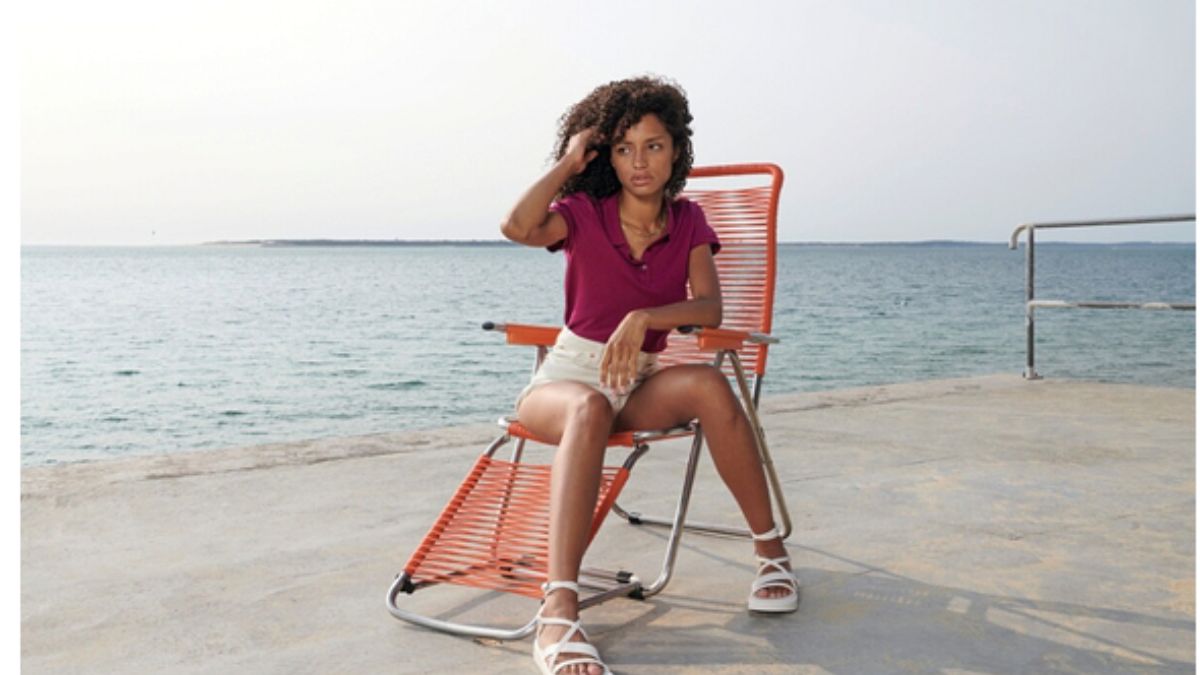
Promotional polo shirts are a great way to promote your brand while also offering customers or employees practical and stylish everyday clothing. They are flexible, so they reinforce the visual identity of any company at any time. To find out how these garments can effectively and permanently increase your brand recognition, we encourage you to read this article.
What is a promotional polo shirt?
A polo shirt is a promotional textile product used by companies to promote their brand or convey their advertising message. It is made of comfortable fabric, often with stylish patterns and combining elegance and functionality, with the company’s logo or slogan on the sleeve, front or back of the shirt.
This piece of clothing is ideal as a corporate gift or as a uniform for employees. As well as reinforcing the brand image, it can be used to convey a message in a subtle but effective way.
One of the main advantages of promotional polo shirts is their versatility. They can be used in a variety of sectors, from retail to catering and sports. In addition, they are considered to be a quality garment, which enhances the image of the company distributing it.
By giving a promotional polo shirt to your customers or partners, you’re also strengthening business relationships. It is a particularly nice gesture that allows you to maintain a harmonious visual connection with your brand.
Why are polo shirts ideal for advertising?
Polo shirts are a particularly effective advertising product for a number of reasons. Their classic and versatile nature makes them a universal choice, suitable for many occasions and a wide range of people. Polo shirts can be easily adapted to any situation, be it a corporate event, a trade fair or a casual outing.
In addition, polo shirts offer a large print area, ideal for displaying logos or advertising slogans. This increased visibility allows you to increase brand awareness in a subtle but effective way.
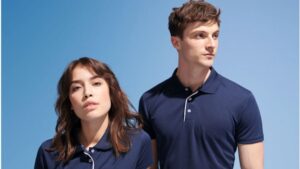
Another great advantage of polo shirts is their comfort. The soft and breathable materials they are made of can ensure that they are comfortable to wear all day long. This comfort encourages people to wear them regularly, which undoubtedly increases brand awareness. In addition, polo shirts are available in a wide range of colours and styles, allowing the products to be adapted to the specific needs of each campaign.
They also have a long durability, which means that promotional messages will be visible for a long time. Unlike other more short-lived promotional products, polo shirts are durable garments that stand the test of time and repeated washing.
Some examples of successful brands that have used promotional polo shirts
Promotional polo shirts can change the perception of a brand and many companies have successfully used this strategy to reinforce their image and reach their audience.
Take Nike, which dressed its teams and partners in polo shirts with its iconic logo. This approach not only reinforces brand consistency, but also brand awareness. Polo shirts become elements of recognition and loyalty for fans.
Red Bull is another benchmark in this area. This energy drink brand uses polo shirts for its sporting events and promotional teams. These garments allow the logo to be displayed in a subtle but pervasive way, therefore creating a direct link with the participants.
Similarly, the coffee shop chain Starbucks has used personalised polo shirts for its employees during work and promotions. By wearing this promotional item, employees create a consistent and professional atmosphere while showcasing the iconic Starbucks brand logo.
These few examples show that well chosen and strategically used personalised polo shirts can play a key role in reinforcing a company’s brand image and engaging the public. They offer constant visibility and reinforce a company’s identity, while being stylish and practical.
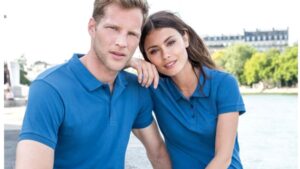
How can promotional polo shirts build customer and employee loyalty?
Promotional polo shirts, often considered formal wear, have proven to be a key element in building customer and employee loyalty. As a means of visibility, they allow companies to reinforce their brand image in a subtle and effective way.
Personalised polo shirts are a way for customers to create an emotional connection with a brand. Offering a quality garment with a company logo reinforces a sense of belonging and increases customer value by giving them a product they can use every day. This attention to detail helps to create a positive image of the company, which in turn promotes customer loyalty.
Branded polo shirts for employees play a similar role. Worn at corporate events or on a daily basis, they create a sense of unity and cohesion within the team. They are also a great tool to promote a transparent company culture, linking the values of the organisation with tangible accessories that employees are proud to wear.
In addition, personalised polo shirts are often seen as a reward or a sign of recognition. Offering them as a reward for a job well done or to mark a special event increases employee motivation and commitment. They are a constant visual reminder of the company’s recognition and appreciation.
How can you maximise the impact of promotional polo shirts?
Promotional polo shirts are a powerful tool for any advertising strategy and personalisation plays an important role in their impact. Here are some ways to maximise their impact:

Choosing the right logo placement
For optimal visibility, logos should be placed in strategic locations. The best places are on the chest, sleeves and back. A logo on the chest is often the preferred choice as it is immediately noticeable when the person is facing you. For a more discreet but equally powerful effect, a logo on the sleeve can draw attention when the person moves their arms. Finally, a logo on the back provides visibility from the side or back, ideal for events where participants move around a lot.
Choice of colours
The colour of the polo shirt makes a decisive contribution to brand recognition. It is important to choose colours that are consistent with the brand identity. Bright, bold colours will attract attention and reinforce your brand presence. For example, if your brand is associated with certain colours, using these shades on polo shirts will help to create a strong visual association. You should also ensure that the colours chosen do not affect the legibility of the logo, as good contrast is needed for optimum visibility.
Quality of materials
Materials not only affect the appearance, but also the comfort of a garment. It is therefore important to choose high-quality fabrics that are comfortable to wear and resistant to washing. Materials such as combed cotton or polyester/cotton blends provide excellent comfort and durability. A well-designed and comfortable polo shirt will encourage people to wear it more often.

Other points to be taken into account
⦁ Consider the cut of the polo shirt, as a design that adapts to different body shapes means your clients or partners will feel comfortable wearing it. Be sure to choose a male and a female model, which will help to increase the acceptance and distribution of your product.
⦁ Don’t forget the importance of details. Things like quality embroidery, personalised buttons or an internal label add a touch of professionalism. These little touches show your attention to detail and reinforce the perception of your brand.
⦁ Finally, the distribution of polo shirts should also be well considered. Offer them at relevant events or strategic moments such as product launches or company parties. This will maximise your impact.
In short, a successful promotional polo shirt is the result of careful design, impeccable quality, attention to detail and smart distribution. Combine these elements and your polo shirts will make a lasting impression.
Promotional polo shirts bring lasting benefits in terms of increasing the visibility of any brand. By incorporating this effective tool into your overall marketing strategy, you will not only increase your exposure, but also your long-term brand awareness. In this sense, they are a good investment for any company looking to improve its image and impact.
FASHION
Dinner Suit vs Business Suit: The Complete Guide to Men’s Formalwear
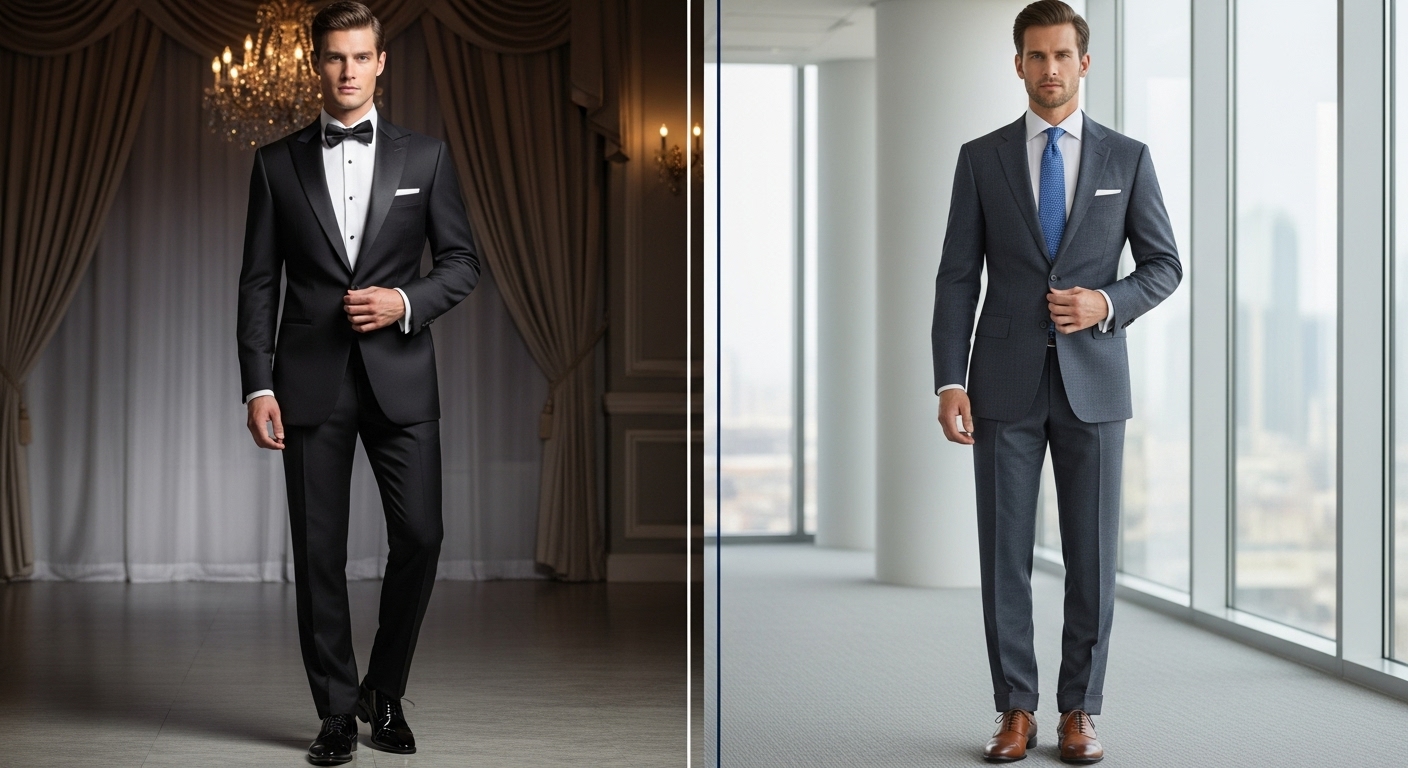
Dressing appropriately can elevate your confidence and ensure you make the right impression. Yet many people still confuse a dinner suit vs business suit—two staples of men’s wardrobes that serve very different purposes. Whether you’re preparing for a black-tie event or an important meeting, understanding these differences is essential. In this guide, we’ll break down definitions, uses, styling tips, and etiquette so you can choose the right suit for any occasion.
Understanding Dinner Suit vs Business Suit
What Is a Dinner Suit?
Also known as a tuxedo, a dinner suit is traditionally worn for evening formal events. Typical features include:
-
Black or midnight blue fabric
-
Satin or grosgrain lapels and stripe on trousers
-
Single-button jacket closure
-
Paired with a formal shirt, bow tie, and patent leather shoes
What Is a Business Suit?
A business suit is designed for daytime professional settings. It is more understated and versatile than a dinner suit:
-
Often in gray, navy, or charcoal
-
Two or three buttons on the jacket
-
No satin or glossy finishes
-
Paired with a dress shirt, tie, and leather dress shoes
Key Differences Between Dinner Suit vs Business Suit
| Feature | Dinner Suit (Tuxedo) | Business Suit (Office Wear) |
|---|---|---|
| Occasion | Black-tie events, galas, weddings | Office, meetings, presentations |
| Fabric & Finish | Satin lapels, glossy trims | Matte wool or blends |
| Shirt & Tie | Wingtip or pleated shirt with bow tie | Standard dress shirt with tie |
| Accessories | Cummerbund or waistcoat | Belt and conservative tie |
| Shoes | Patent leather | Polished leather oxfords |
Why It Matters to Know the Difference
Social Etiquette
Wearing the wrong outfit can send the wrong message. Knowing when to choose a dinner suit vs business suit ensures you respect dress codes.
Professional Impression
In business settings, a sharp, tailored suit signals professionalism. In formal settings, a tuxedo signals sophistication.
Investment Value
High-quality suits can be expensive. Understanding their uses helps you make informed purchases that last for years.
Styling Tips for Dinner Suits
-
Opt for black or midnight blue for timeless appeal
-
Choose satin or grosgrain lapels for authentic style
-
Pair with a crisp white dress shirt and black bow tie
-
Accessorize minimally—cufflinks and a pocket square are enough
Common Mistakes to Avoid
-
Wearing a necktie instead of a bow tie
-
Choosing colors like gray or brown for formal black-tie events
-
Using business shoes instead of patent leather shoes
Styling Tips for Business Suits
-
Select neutral colors like navy, charcoal, or gray for versatility
-
Ensure proper fit: shoulder seams should align with your shoulders
-
Pair with conservative dress shirts and ties for a professional look
-
Rotate suits to extend their lifespan
Common Mistakes to Avoid
-
Wearing flashy colors or patterns in conservative industries
-
Using casual shoes or sneakers
-
Neglecting tailoring, which can ruin the suit’s silhouette
Benefits of Understanding Dinner Suit vs Business Suit
Professionals
-
Improves credibility in workplace settings
-
Ensures appropriate attire for business events
Social Events
-
Avoids embarrassment at formal functions
-
Signals respect for the event host and tradition
Budget Planning
-
Helps you decide whether to invest in or rent a dinner suit
-
Guides you in building a versatile wardrobe
Challenges in Choosing Between Dinner Suit vs Business Suit
Overlapping Styles
Some modern suits blur the line between business and formalwear. Always check event dress codes for clarity.
Cost Considerations
A well-made dinner suit can be more expensive than a business suit. Renting may be an option for occasional events.
Changing Trends
Fashion evolves. Today’s tuxedos may include slimmer cuts and more colors, while business suits may feature softer tailoring. Keep your wardrobe updated but timeless.
Practical Examples
Example 1: Corporate Gala
You’re invited to a black-tie corporate event. This is a clear case for a dinner suit—think tuxedo, bow tie, and patent leather shoes.
Example 2: Client Presentation
You’re pitching to a potential investor. This is a business setting, so opt for a navy or charcoal business suit with a conservative tie.
Example 3: Wedding Guest
If the invitation says “black tie,” you need a dinner suit. If it says “business formal,” a dark business suit is sufficient.
Long-Tail Variations of the Keyword
-
Difference between a dinner suit and a business suit
-
Dinner suit vs business suit etiquette guide
-
How to style a dinner suit vs business suit
-
When to wear a dinner suit instead of a business suit
These variations help clarify search intent and improve SEO relevance.
Looking Ahead: The Evolution of Dinner Suit vs Business Suit
Men’s formalwear is continually evolving. Designers are experimenting with fabrics, cuts, and colors to modernize classic pieces. In the future, we may see:
-
Eco-friendly materials: Sustainable fabrics for both dinner suits and business suits
-
Versatile designs: Hybrid suits suitable for multiple settings
-
Smart tailoring: Technology-driven fit adjustments for greater comfort
By staying informed, you can keep your wardrobe timeless yet current, making confident style choices for any occasion.
FAQs About Dinner Suit vs Business Suit
1. Can I wear a business suit to a black-tie event?
Not ideally. Black-tie events call for a dinner suit or tuxedo. A business suit may look underdressed.
2. Is a dinner suit the same as a tuxedo?
Yes. In most countries, “dinner suit” and “tuxedo” are interchangeable terms.
3. Can I use the same shoes for both dinner suits and business suits?
You can, but it’s best to wear patent leather shoes with a dinner suit and polished leather oxfords with a business suit.
4. Should I buy or rent a dinner suit?
If you attend multiple black-tie events annually, buying may be cost-effective. Otherwise, renting is practical.
5. What colors are acceptable for business suits?
Navy, charcoal, and gray are standard. Avoid loud patterns in conservative workplaces.
Conclusion
Understanding the difference between a dinner suit vs business suit is essential for anyone navigating professional and formal events. A dinner suit (or tuxedo) elevates your style for black-tie occasions, while a business suit projects professionalism in workplace settings. By choosing the right outfit, you show respect for the occasion and enhance your confidence.
Looking to upgrade your wardrobe? Invest in high-quality pieces that suit both your lifestyle and your professional needs—because the right suit can transform your appearance and your impact.
FASHION
Raisin Your Voice Nail Polish: How One Beauty Brand Is Bestowing Confidence, Creativity, and Purpose
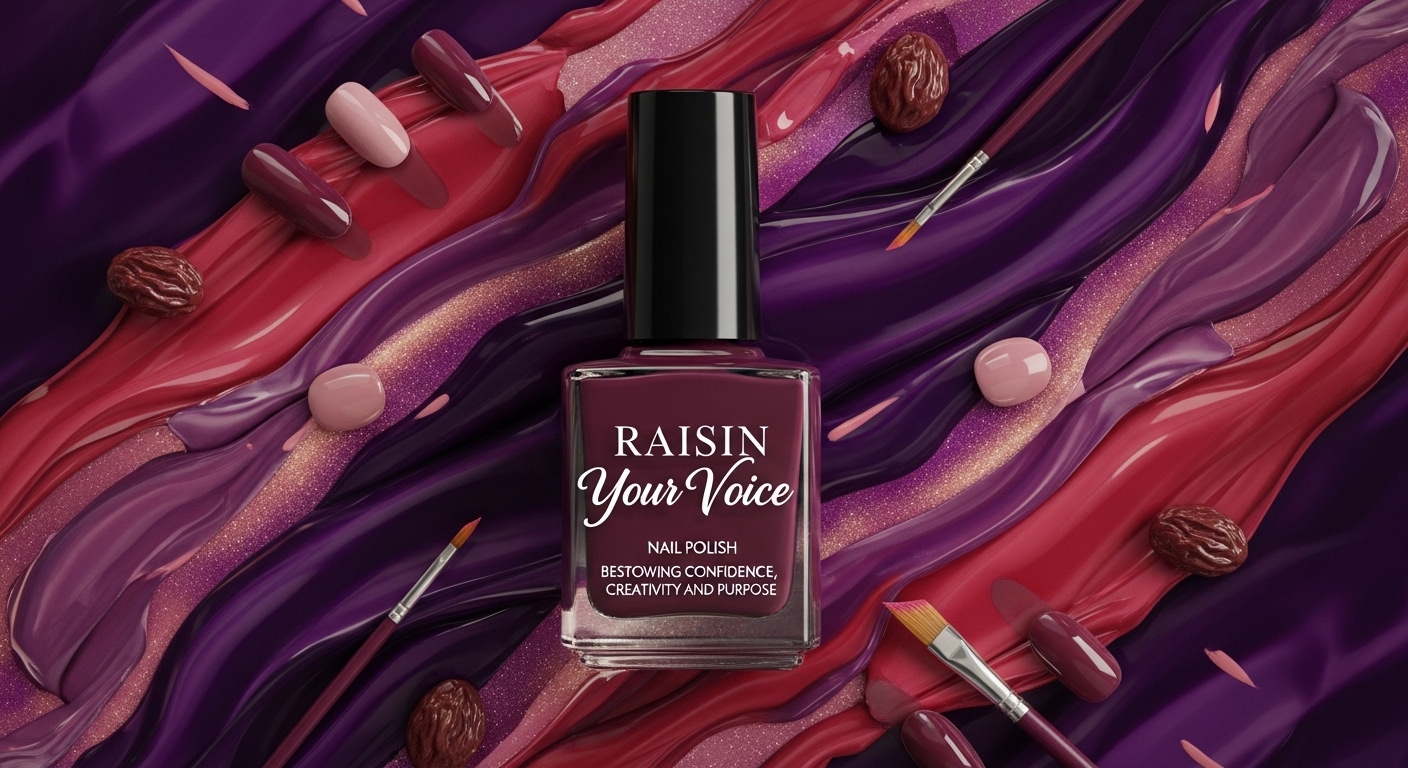
In the sprawling universe of beauty and cosmetics, few products resonate as deeply as nail polish. It is more than just color on nails—it’s self-expression, artistry, and identity. Among the latest entrants making a difference is Raisin Your Voice Nail Polish, a brand that’s redefining what it means to adorn your hands. Combining high-quality formulation with a mission rooted in empowerment and sustainability, Raisin Your Voice Nail Polish is opening doors for creativity and confidence, while also delivering real, meaningful impact.
Who Is Raisin Your Voice Nail Polish?
Raisin Your Voice Nail Polish isn’t just another lacquer on the shelf. Founded by beauty lovers and advocates for self-expression, the brand’s core belief is that every nail stroke should carry voice, strength, and artistry. The name itself—“Raisin Your Voice”—evokes the idea of amplifying one’s self through beauty, turning a simple manicure into a platform for visibility and self-empowerment.
From the very beginning, Raisin Your Voice Nail Polish has spared no effort in creating shades that are bold, inclusive, and emotionally resonant. Whether you choose a pastel whisper, a neon scream, or a classic crimson, each shade is meant to reflect something inside you—a mood, an identity, a statement.
A Philosophy Built on Purpose
Just like leading business changemakers strive to balance profit with values, Raisin Your Voice Nail Polish holds purpose at its center. Its philosophy can be grouped into three principle pillars:
1. Self-Expression & Confidence
The brand believes your nails are a canvas. Raisin Your Voice Nail Polish empowers customers to articulate their personality—what they stand for, how they feel, who they are—just through color and design. Rather than fitting into trends, the brand encourages individuals to set their own.
2. Sustainability & Ethics
In today’s world, beauty brands are called to do more than look good—they must do good. Raisin Your Voice Nail Polish sources non-toxic, cruelty-free ingredients, avoids harmful chemicals like formaldehyde and toluene, and uses packaging that is recyclable or made with recycled materials. Environmental consciousness isn’t an afterthought; it’s built into every batch.
3. Community & Inclusion
From inclusive shade ranges that look good on all skin tones to partnerships with local artists and advocacy groups, Raisin Your Voice Nail Polish invests in more than just the market—it invests in people. It supports causes such as mental health awareness, body positivity, and creative arts programs. By offering workshops, scholarships, and “paint nights” in underserved communities, the brand invites participation, not just consumption.
Where Purpose Meets Performance
For a brand with a strong mission, Raisin Your Voice Nail Polish also understands that high performance is non-negotiable. It’s not enough to mean well; the polish must look gorgeous, chip-resistant, smooth, fast-drying, and long-lasting. Here’s how Raisin Your Voice Nail Polish manages to bridge performance with purpose:
-
Formulation excellence: Their lab teams work to ensure rich pigmentation so fewer coats are needed. The polish dries quickly, with a glossy finish, and adheres well to natural and artificial nails alike.
-
Color innovation: Regular seasonal launches aren’t just about what’s trending—they’re storytelling: a collection inspired by a social theme, a heritage art form, or a cultural event. One collection might draw from street art murals; another from climate activism or indigenous craft.
-
Accessibility: Raisin Your Voice Nail Polish keeps pricing fair and transparent. There are options at different price points, with mini sizes or bundles for those exploring many colors. Shipping is made global with mindful packaging, and the brand offers salon-level quality at accessible cost.
Digital Savvy in the Age of Influence
Beauty is intensely visual and socially shared. Raisin Your Voice Nail Polish leverages this by embracing digital media not merely for sales, but for storytelling. Here are some of their strategies:
-
Authentic storytelling: Through blog posts, video tutorials, and user spotlights, the brand shares real stories—about women, non-binary creators, artists—who use color to express identity. These narratives feature challenges and triumphs, not just glossy nails.
-
Social engagement overload: On Instagram, TikTok, and YouTube, the brand hosts “Color Your Voice” challenges, inviting customers to design nail art that reflects their voice—whether that’s a message, lifestyle, political statement, or personal journey. The winning entries are sometimes turned into limited edition shades.
-
Educational content: From proper application tips to nail health, from how to avoid damaging your nails to how to recycle polish bottles, Raisin Your Voice Nail Polish educates. They are committed to entire customer well-being, not just beauty.
-
Transparency and dialogue: Ingredient lists are shared plainly. The brand admits when improvements are needed. Customer feedback is not an afterthought—it shapes future formulations and collections.
Why Raisin Your Voice Nail Polish Matters
In the beauty industry, there are many polish brands—but few merge artistry, ethics, and authenticity in quite the same way. Raisin Your Voice Nail Polish is significant because it answers several modern demands at once:
-
For the customer who wants beauty without compromise—without toxic ingredients, without exploitative labor, without homogenized shade lines.
-
For the creator who sees nails as art, as statement, as a way to amplify identity.
-
For shoppers who believe that brands should give back—to communities, to the environment, to culture.
-
For influencers and content creators who seek deeper stories, not just product placement.
In short, it helps beauty be more meaningful, not just more marketable.
Challenges and Opportunities Ahead
Despite its promising foundation, it faces its share of obstacles. What balances can it strike as it grows?
-
Scaling while maintaining ethics: As demand increases, supply chains become more complex. How to ensure every batch remains cruelty-free, every worker safe, every ingredient tested for safety?
-
Cost pressures: Sustainable materials, clean ingredient sourcing, ethical labor—all these come with higher costs. The brand must keep prices accessible without sacrificing its values.
-
Breaking through the noise: The beauty market is saturated. Differentiation through values helps, but the brand still must deliver exceptional aesthetic appeal, marketing ingenuity, and customer service.
-
Staying relevant without dilution: As it expands, there’s a risk of spreading too thin—too many collections, too many collaborations—which could dilute the core message of voice, expression, purpose.
Yet these challenges are also opportunities. For instance, scaling ethically often prompts innovations in materials or logistics; cost pressures can inspire minimalist or modular packaging; noise in the market can drive deeper community-based marketing; staying relevant can stimulate creative collaborations with underrepresented artists or activist organizations.
The Future: Raising Your Voice, One Nail at a Time
As consumers increasingly demand that beauty brands reflect their values—not just their vanity—Raisin Your Voice Nail Polish is positioned at a sweet intersection. The coming years might see:
-
Deeper integration of eco-technologies (biodegradable bottles, refill systems).
-
Even more inclusive color palettes and custom colors generated using AI or customer co-creation.
-
Strategic partnerships with nonprofits tied to expression: art therapy, youth mentorship, mental health advocacy.
-
Global expansion that respects cultural diversity in color preferences, nail care traditions, and aesthetic norms.
-
Expansion into nail care accessories—non-toxic removers, strengthening bases, cuticle oils—all under the same ethos of voice, care, and authenticity.
A Model for Beauty-Driven Leadership
Raisin Your Voice Nail Polish leads the beauty industry with purpose. First, it amplifies voices rather than simply chasing market share. Moreover, it prioritizes purpose over profit. In fact, the brand proves that true success arises from empowering people. Therefore, it enables customers to embrace identity, inclusion, and impact. Meanwhile, it reshapes how beauty brands engage their communities. Furthermore, it inspires others to see leadership as service. Because of this, Raisin Your Voice Nail Polish embodies a higher standard for the industry.
At the same time, it makes every shade a statement. Indeed, each bottle tells a story of values as much as color. Likewise, it sparks conversations that go beyond trends. Consequently, it shifts beauty from a product to a movement. Above all, it shows that beauty can be louder than gloss and stronger than trend. As a result, it redefines the meaning of lasting impact. Finally, Raisin Your Voice Nail Polish invites everyone to wear their truth proudly.
FASHION
Hat Size Chart: Redefining Fit, Fashion, and Confidence
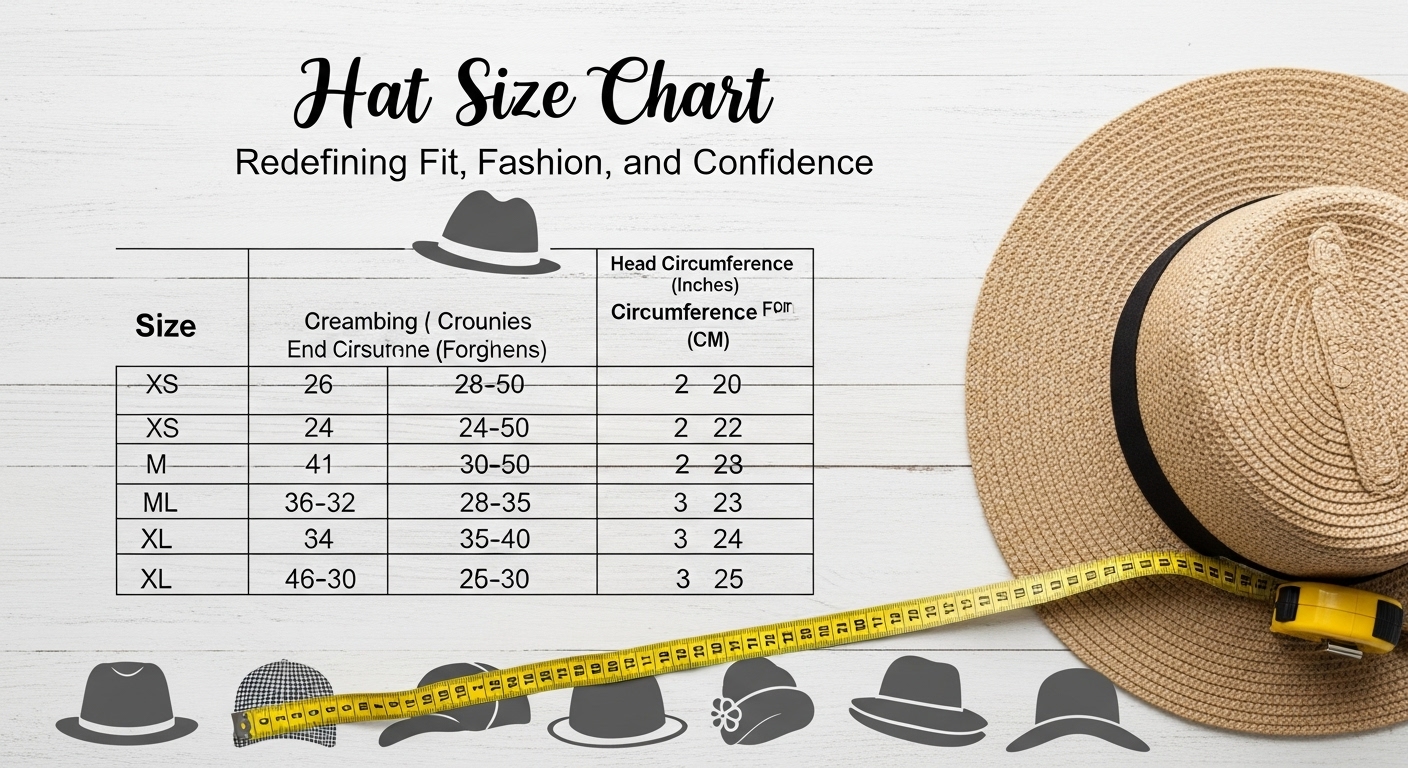
In today’s style-conscious and digitally driven world, personal expression no longer stops at clothes—it extends to accessories, especially hats. Yet as diverse as hat designs have become, one timeless challenge remains: finding the perfect fit. That’s why the hat size chart has emerged as more than a simple measurement tool—it’s a bridge between style, comfort, and confidence.
This article explores the rise of the hat size chart, why it matters, and how it’s reshaping the way people shop, style, and experience hats.
What Is a Hat Size Chart?
At its core, a hat size chart is a standardized guide that converts head measurements into hat sizes. It helps consumers and retailers alike find the right fit across different brands, regions, and styles. Because sizing systems can vary widely (U.S., U.K., European, metric), a clear chart eliminates confusion, reducing the risk of returns and dissatisfaction.
Just as a size guide revolutionized online clothing shopping, the hat size chart is making hat-buying easier and more accurate.
Why the Hat Size Chart Matters
-
Consistency Across Brands
Hat makers use different sizing standards. Without a hat size chart, a “Medium” in one brand might feel like a “Large” in another. The chart acts as a translation tool between systems. -
Comfort and Functionality
Hats aren’t just for fashion—they provide sun protection, warmth, and performance benefits. A poor fit can compromise comfort and utility. -
Inclusivity
A comprehensive hat size chart embraces a range of head sizes, ensuring everyone finds a style that fits—an important nod to diversity and inclusivity in fashion. -
Confidence Boost
When a hat fits perfectly, wearers feel confident. The right size enhances posture, expression, and personal style.
How Hat Size Charts Have Evolved
Historically, hat sizes were informal—tailors or milliners would custom-fit hats. As mass production grew, so did the need for standardized sizing. Modern hat size charts combine:
-
Numeric Sizing (e.g., 6 7/8, 7 ¼)
-
Letter Sizing (S, M, L, XL)
-
Centimeters/Inches (head circumference)
Today, many online retailers integrate interactive hat size charts, letting customers input their head measurements and instantly see recommended sizes across brands.
Anatomy of a Modern Hat Size Chart
A typical hat size chart includes:
-
Head Circumference in centimeters or inches
-
U.S. Hat Size in numeric format (6 ⅝ – 8)
-
International Conversion to U.K./European or letter sizing
-
Fit Notes (if a style runs large or small)
Some charts even show how certain materials (wool, felt, straw) behave over time—whether they stretch or shrink.
The Leadership Behind the Hat Size Chart Revolution
While no single person “owns” the hat size chart, many designers, brands, and e-commerce innovators have championed more transparent and consistent sizing. These leaders recognize that sizing is not simply logistics—it’s a customer experience issue.
Their approach mirrors modern leadership principles:
-
Empathy: Understanding that consumers want ease and confidence.
-
Sustainability: Reducing returns and waste by helping customers choose correctly the first time.
-
Collaboration: Brands, retailers, and tech platforms working together to standardize sizing.
In this sense, the hat size chart reflects a broader shift toward customer-centered fashion.
Bridging Style, Fit, and Technology
Much like purpose-driven business leaders merge strategy with social impact, the most innovative hat brands integrate style, fit, and technology. They’re using data from hat size charts to:
-
Offer Custom Recommendations: AI-driven tools that predict best fits based on previous purchases.
-
Improve Manufacturing: Adjusting patterns to reduce “off-size” products.
-
Enhance Online Shopping: Offering AR (augmented reality) try-ons combined with a live hat size chart to ensure accuracy.
Hat Size Chart as a Model for Inclusivity
Younger consumers—particularly Millennials and Gen Z—value authenticity, inclusivity, and global awareness. The hat size chart speaks to these values because it:
-
Recognizes differences: No one-size-fits-all.
-
Provides transparency: Clear numbers instead of vague labels.
-
Breaks down barriers: Allows cross-border shopping without confusion.
Just as socially minded leaders mentor others, brands using comprehensive size charts are educating shoppers about fit and encouraging confidence.
Common Challenges in Hat Sizing
Even with a hat size chart, challenges remain:
-
Measurement Accuracy: Many people measure incorrectly, leading to wrong sizes.
-
Variations by Style: A fitted cap differs from a floppy sunhat.
-
Material Behavior: Wool may shrink; straw may loosen.
These issues mirror business challenges: balancing standardization with personalization, and accuracy with flexibility.
Overcoming Sizing Challenges
Forward-thinking brands use their hat size chart as part of a larger education campaign. They provide clear instructions for measuring head circumference, sometimes including:
-
Videos showing how to measure above the ears and across the forehead.
-
Printable Tape Measures or online tools.
-
Customer Service Support for nuanced questions.
This proactive approach reduces returns and strengthens customer loyalty.
The Digital Age of Hat Size Charts
In the digital era, content is king—and so is clarity. Successful retailers now:
-
Display their hat size chart prominently on product pages.
-
Integrate filters so shoppers can see only hats in their size.
-
Offer personalized accounts where previous purchases inform future recommendations.
-
Share educational posts and reels about sizing tips on Instagram, TikTok, and Pinterest.
This not only helps customers but positions brands as trusted advisors rather than mere sellers.
Looking Ahead: The Future of the Hat Size Chart
As the market becomes more global and technology-driven, the hat size chart will continue evolving. Expect to see:
-
Smart Hats with adjustable bands and digital measurement tracking.
-
Virtual Fittings where 3D scanning apps measure your head and sync with retailers.
-
Universal Sizing Standards agreed upon by multiple major brands.
Just as leaders like Molly Noblitt represent a paradigm shift in business, the hat size chart represents a paradigm shift in retail—away from guesswork, toward transparency and empowerment.
Why the Hat Size Chart Matters More Than Ever
In a world where consumers expect instant gratification and perfect fit, the hat size chart is more than a convenience—it’s a necessity. It empowers shoppers, reduces environmental waste from returns, and promotes confidence.
Whether you’re a first-time hat buyer or a seasoned collector, understanding and using a hat size chart is the first step toward building a headwear collection that truly fits—both physically and stylistically.
Conclusion
The hat size chart may seem like a small detail, but its impact on consumer experience, brand trust, and sustainability is enormous. As hats become more integral to personal style, the chart becomes a crucial tool for ensuring everyone—regardless of head size or geographic location—finds the right fit.
Just as new leadership paradigms value empathy, transparency, and inclusion, it embodies these principles in retail form. By prioritizing clarity and customer-centric design, it reshapes not only how we shop for hats but also how we feel wearing them.
-

 HEALTH1 year ago
HEALTH1 year agoIntegrating Semaglutide into Your Weight Loss Plan: A Practical Guide
-

 HOME IMPROVEMENT1 year ago
HOME IMPROVEMENT1 year agoHow to Choose the Perfect Neutral Area Rug for Every Room
-

 LAW1 year ago
LAW1 year agoTeenage Drivers and Car Accidents in California: Risks and Parental Liability
-

 LAW1 year ago
LAW1 year agoPost-Divorce Considerations in California: Modifications and Long-Term Planning
-

 CONSTRUCTION1 year ago
CONSTRUCTION1 year agoConstruction Site Safety Regulations in New York and Your Rights as a Worker
-

 HOME1 year ago
HOME1 year agoSandra Orlow: The Teen Model Who Captivated the Internet
-

 FINANCE1 year ago
FINANCE1 year agoDigital Asset Management in Florida Estate Planning
-

 LAW1 year ago
LAW1 year agoKentucky’s School Football: Concussions, Injuries, and Legal Options
